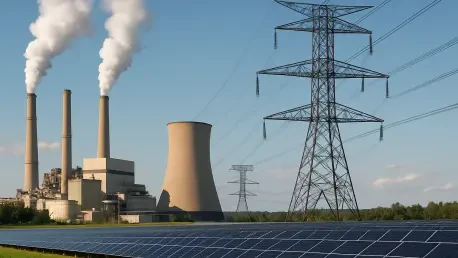Setting the Stage for a Power Market Revolution
The U.S. power sector is experiencing a seismic shift, with electricity demand surging at rates not seen in decades, driven by data centers, electric vehicles, and industrial growth. This unprecedented growth, projected to increase by 1.1% to 2.2% annually through 2035, collides with sweeping policy changes introduced by the One Big Beautiful Bill Act (OBBBA). Combined with tariffs and trade restrictions, this federal initiative has unleashed a wave of uncertainty and opportunity across the energy landscape. This analysis aims to dissect how these forces are redefining cost structures, project timelines, and strategic decisions for both renewable and conventional energy resources. By exploring key trends, data, and projections, the goal is to equip stakeholders with insights to navigate this complex and rapidly evolving market environment.
Deep Dive into Market Trends and Projections
Demand Surge: The New Normal in Electricity Needs
A fundamental driver reshaping the U.S. power market is the robust growth in electricity demand, fueled by transformative sectors. Data centers, supporting the digital economy, alongside the proliferation of electric vehicles and a manufacturing renaissance, are pushing consumption to new heights. Forecasts indicate this trend will persist, with annual growth rates sustained over the next decade. Such momentum signals a pressing need for expanded generation capacity, challenging utilities and developers to keep pace with an accelerating load profile that shows no signs of slowing.
Policy Shockwaves: Cost Impacts and Economic Uncertainty
The introduction of the OBBBA, paired with stringent trade policies like Anti-Dumping and Countervailing Duties (AD/CVD) tariffs, has dramatically altered the economic calculus for energy projects. Solar initiatives, heavily dependent on imported components, face capital cost spikes ranging from 30% to over 300%, with levelized costs potentially soaring by up to 470%. Wind projects, though less impacted by tariffs, grapple with shortened tax credit windows and barriers to public land development. These policy-driven cost shocks are creating a turbulent environment, forcing market participants to reassess project viability and timelines under tight constraints.
Market Responses: Fragmentation and Strategic Divergence
Amid this uncertainty, the power market exhibits a fragmented response, with developers adopting divergent strategies to manage risks. Some are racing to secure equipment and finalize contracts before incentives lapse, while others hesitate, awaiting clearer policy signals. This has led to significant price dispersion across projects, even within similar technologies, as well as renegotiated agreements and demands for offtaker protections. The potential for boom-and-bust cycles looms large, as a rush to build could oversaturate certain regions, only to be followed by stagnation if federal support diminishes after 2028.
Technology and Regional Dynamics: A Varied Impact Landscape
The effects of the OBBBA ripple differently across technologies and geographic areas, adding layers of complexity to strategic planning. Battery storage, often integrated with solar, faces predictable cost increases due to reliance on imported lithium-ion cells, compounded by compliance risks with Foreign Entities of Concern (FEOC) regulations. Natural gas, particularly combined cycle gas turbines, emerges as a relative winner in high-tariff scenarios, meeting the steady power demands of data hubs. Regionally, industrial zones may lean toward gas solutions, while states with strong renewable portfolios could see growth slow unless domestic supply chains emerge to offset tariff burdens.
Future Outlook: Volatility and Innovation on the Horizon
Looking ahead, the U.S. power market is poised for continued volatility, shaped by policy swings and technological advancements. Frequent market accelerations or pauses tied to political shifts are anticipated, diminishing expectations for stable incentives akin to past frameworks. Innovations in domestic renewable supply chains and next-generation storage solutions could mitigate some cost pressures, though regulatory changes beyond 2028 remain unpredictable. A hybridized energy mix appears likely, with natural gas bridging near-term gaps while renewables navigate cyclical challenges, setting the stage for a dynamic decade ahead.
Reflecting on the Path Forward
Looking back, this analysis illuminated the profound transformation that unfolded in the U.S. power markets under the influence of the One Big Beautiful Bill Act and associated policies. The surge in electricity demand and the economic turbulence introduced by tariffs and shortened incentives painted a landscape of both challenge and potential. For stakeholders, the journey ahead demanded a focus on adaptability—embedding flexibility into resource planning to handle diverse scenarios, prioritizing modular development to pivot with policy shifts, and diversifying energy portfolios to balance risks. Strategic procurement with established partners and contracts designed for agility emerged as critical steps to mitigate cost surprises. Ultimately, the lesson was clear: resilience and foresight became the cornerstones for thriving in an era of uncertainty, offering a foundation to build a sustainable energy future.









